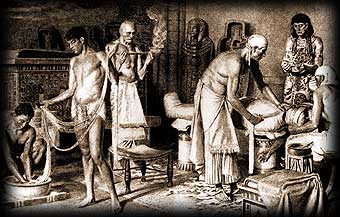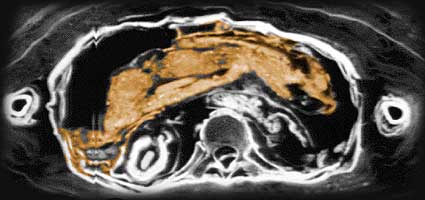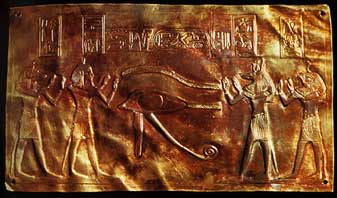 |
|
 |
|

|
THE MUMMIFYING RITUAL 1. Purification Soon after death, the embalmers were called - they would then carry the deceased away to be embalmed, this lengthy proceedure would take place in the IBU (the 'Tent of Purification'). During this 70 day embalming period (70 days also the period for the journey of the Decans in the underworld), the embalming was not only would a surgical and drying process take place, but also a highly ritual process. The embalmers themselves would assume roles whilst embalming the deceased : the Chief Embalmer (the 'Controller of the Mysteries') was Anubis, the jackal headed god of cemeteries and embalming, the God's Seal Bearer assisted the Chief Embalmer, a Lector Priest was present in order to read spells throughout, the Ripper-Up, PARASCHITES, made the incision for removal of the internal organs minor priests - WTW - carried out bandaging and other similar duties The first step for the body on the road towards mummification was the purification - the body was washed and cleansed using water containing natron (natron was the drying agent, this step was not part of drying the body out, that would come later).
2. Removal of the Organs Once the body had been cleaned from any impurities it was taken to the 'Place of Embalming' - the WABET. It was here that the internal organs were removed - this included the lungs, stomach, intestines and liver (kidneys were often left in place, this may be because they were thought to have little importance), these were removed through an inscision on the side of the body:
Once the organs were removed, the remaining space within the body was then cleansed and filled with a temporary stuffing - the organs were treated with the same proceedure as the rest of the body, they were even individually wrapped in linen and placed in the tomb. The placement of the internal organs in the tomb varies - up to the 21st dynasty they were placed within canopic jars, during the 21st dynasty the organs (still wrapped in linen) were placed back in the body, and in the Late Period the organs were placed between the legs of the mummy.  The brain was also removed (this practice seems to have started around the time of the late Middle Kingdom, or early New Kingdom period onwards), a hole was punched through the thin bone at the top of the nostrils (the Ethmoid bone) - modern experiments made by Bob Brier, have shown that the brain needs to be 'whisked up' into a sort of liquid before the body is placed face-down allowing the brain then to pour out through the nose. Sometimes an incision at the base of the neck would be used to removed the brain. Once the brain had been removed, a coating of resin was then applied to the face. The one organ that was not removed was the heart - the heart was seen as most important to keep within the body, it was thought of as the place of wisdom, intelligence in the body. If the deceased were ever to reach the Beyond it was essential that the body and heart were not separated (the heart was needed in the Weighing of the Heart ceremony), The heart was not to be cut from the body - if this happened accidently with the removal of the other internal organs then it was later put back.
The bath of Natron Possibly on the 16th day after death, the body was put into a bath of natron - modern analysis has identified this as a natural salt of Sodium Carbonate, Sodium Bicarbonate (along with some smaller amounts of Sodium Sulphate and Sodium Chloride). The cavities made in the body by the extraction of the internal organs were also packed with natron - so that the drying process caused by the natron happened both inside and outside the body. It was originally thought that the body was laid into a water solution which held the natron - but it is now known that the desired results are only achievable when the natron is dry and literally heaped onto the body. After 40 days the body would have been completely dessicated - all moisture would have been removed, and the body safe from further decay. It was at this point in some periods that the mummies were also covered with hot resin as a further protection against decay (for example the mummy of Tutankhamun). In the 3rd Intermediate period mummies had linen and other items packed under the skin to give the deceased a more life-like appearance (the height of the mummification proceedure dates from thie period).
Anointing and decorating the body After the body had been fully dessicated in the bath of natron it was then moved to the 'House of Beauty' (Per Nefer), it was here that perfumes and oils were rubbed over the skin to make it soft once more. Firstly, however, any materials that had been placed in the body before the bath of natron were taken out and replaced (these original padding materials were not discarded but were kept to be buried with the body), the body was then re-stuffed (this might include linen soaked in resin, lichen, onions, mud or sawdust). Once perfums and oils had been rubbed over the skin (the quality of these oils depended on the wealth of the deceased), the embalming incision was covered - either with wax, or with a metal plate. The metal plate was used for protection and was decorated with a magical symbol: 
The bodies were also sometimes coloured - men were painted red, women painted yellow - henna was rubbed onto the hands and feet. In the Graeco-Roman period gold leaf was applied to parts of the body, and female mummies had their faces painted and their eyes highlighted.
The Wrapping of the Mummy. At least fifteen days were needed to fully wrap the body, this slow process was often interrupted by the need for prayer and ritual. The linen used for the bandages may have come from many different sources - the linen may have been specially made painted with magical inscriptions to protect the mummy, or for the poorer burials ordinary household linen would have been used. The linen used as bandages were torn into strips approximately 2 to 8 inches in width. The limbs of the body would each be wrapped separately at first (the head and neck, toes and fingers, arms and legs followed by the torso). During this wrapping many amulets would be placed within the wrappings - again to protect the mummy in the Beyond:
|